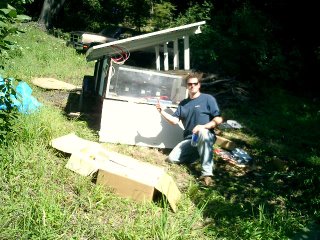The Truck and Conversion Story:
So for about two weeks in November, I spent time emailing back and forth with a guy in Sacramento who had a truck already converted to veggie oil. I had seen his ad on a website that promoted greasecar conversion kits, and was sold on that kit. We talked price, and time for me to come and take a serious look. Of course, it's about 90 miles away, and I didn't have a car, so I had to figure out how to get there... and I kept putting it off. Suddenly, it was Christmas, then New Year's is coming. I email him about the 2nd of Jan, to say I'm coming on Friday. Wednesday, I get an email from him saying he'd been corresponding with someone else, and they drove through with cash in hand, and bought the truck. Do over.
I do more research, find a guy in SF, try to connect with him.. he moves to LA. I discover Frybrid conversion kits, and start trying to contact the owner of that biz to buy a kit. And, in the meantime, shop for a truck. His website is a bit strange though, and while he has a product page, some things don't have prices, and aren't fully explained.
Going around and around about what sort of truck, test driving different ones, trying to figure how old one could get, how much work they might need, how big they are, how many miles is too many... I finally find a kid in Santa Cruz who wants to sell. When I tell him I'll take it, he drives up the next day, creating a scramble for me to have enough money ready for him.
So now I own a 1991 Dodge Ram Turbo. Back to the Frybrid website, and their discussion forum and order page. Reading more posts by customers and would-be customers, it becomes apparent that the owner of Frybrid is not a business man. He can't ship things on time, can't answer questions, do rebates, or follow-through. Apparently it's a great product, but after repeated emails and postings to the discussion forum, I finally get an answer: he doesn't like to sell his kits to Dodge people. It hasn't been fully tested. Funny how I had asked him more than once about what type of truck I should get.
While I'm posting angered WTF posts about this run-around, I get an email from a guy in Berkeley who sells kits. Plantdrive has a good kit, and I can save shipping by just driving over. Done. It only takes two weeks. Then I find out the conversion process is probably over my head, and even includes buying more parts than are in the kit.
This realization knocks the wind out of me for a whole day. Plantdrive charges $2500 to do the install. That's on top of $2700 for (almost all) the parts. oof.
Now I've got all the parts stashed up at Kelly's garage, waiting to see what I can accomplish before giving up and going back to Plantdrive with my hat in my hand.
Addendum: Found a guy (William) on craigslist offering peanut oil, we got to talking, I told him I was looking for a mechanic, and he helped me put the kit in (at $25 an hour) ended up being $800.
Addendum to the addendum: truck runs great. I love getting fuel for free.















































